The global “green revolution” is pushing the boundaries of photonics as governments, companies and citizens work to preserve our world and its resources.
From individual citizens and businesses right up to entire industries and governments, efforts to improve sustainability, reduce carbon footprints and increase energy efficiency are driving new – and sometimes surprising – innovations across the field of photonics.
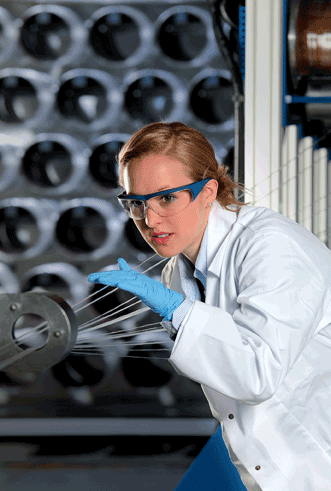
Puravis glass optical fibers are manufactured at Schott’s site in Mainz, Germany, using an environmentally friendly process that does not include lead, arsenic or antimony. Photo courtesy of Schott AG.
Optics, lasers and imaging systems bring greater precision, accuracy and efficiency to almost any industry, from manufacturing and energy generation to agriculture and inspection. And with greater efficiency comes less waste, which has cost benefits for both the user and the environment.
Optics
The introduction of global environmental initiatives over the course of the past several years is keeping manufacturers very busy. And because optics can be found in just about every industry, optics manufacturers are encountering a growing number of eco-friendly requirements.
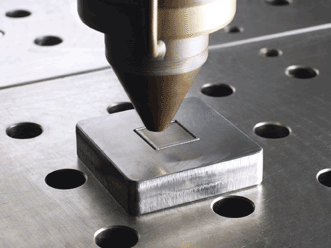
This workpiece has a cuboid generated by laser deposition welding. Photo courtesy of Trumpf GmbH.
“The problem is that new regulations and amendments to existing regulations come out annually, and it is a huge undertaking to be in compliance with these regulations,” said Jay Budd, director of corporate compliance at Edmund Optics, of Barrington, N.J. “Although challenging, we understand the importance of this movement so that we can enjoy our planet for many years to come.”
One key demand from buyers – particularly in Western Europe and Asia – is for optics manufacturers to offer lead-free products.

Schott has expanded its portfolio of lead-free Puravis step-index fibers for illumination applications to include the GOF120 with an aperture angle of up to 120°, making it well suited for applications in the field of medical endoscopy to illuminate internal cavities. Photo courtesy of Schott AG.
“Regulations requiring that older glass containing lead not be used caused the industry to start using the environmentally friendly substrates,” Budd said. “These substrates had to be tested to ensure that they could perform as well as their lead-filled counterparts. This required a lot of testing to assure our customers that the eco-friendly glass could meet the same specifications.”
At Schott AG, a glass specialist with headquarters in Mainz, Germany, engineers have developed an innovative optical fiber, Puravis, that is not only lead-free but is also made using a new, environmentally friendly process. Crucially, the production process avoids using arsenic and antimony as refining agents.
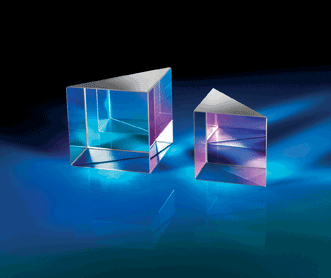
N-BK7, the arsenic- and lead-free successor of BK7, is one of the most popular optical glasses for applications in the visible range. Its optical properties are similar to BK7, simplifying the transition to these eco-friendly optics. Photo courtesy of Edmund Optics.
“In fact, any product that is equipped with Puravis already complies with the EU directives RoHS (Restriction of Hazardous Substances) and REACH (Registration, Evaluation, Authorization and Restriction of Chemicals) without the need for exemptions today, and is ready for future environmental requirements, worldwide,” said Karen Holst, senior product manager medical at Schott Lighting and Imaging.
The company’s environmentally friendly fibers are more chemically stable, which boosts long-term stability and offers improved optical-performance-enabling new applications. The fibers are used for endoscopic investigations, fluorescence diagnostics and industrial inspection.
“We have been experiencing an increasing awareness in the industry for ‘green photonics,’ ” said Dr. Peter Hartmann, director of market and customer relations at Schott Advanced Optics. “[The] main driver for the introduction of lead- and arsenic-free glass types was a voluntary initiative of optical materials manufacturers in the 1990s, long before RoHS and REACH came into force.”
“For optical glasses, exemptions exist for components which are necessary to achieve indispensable product characteristics which are impossible otherwise,” Hartmann added.

Vintage luminaires in the famous Piazza San Marco in Venice, Italy, were retrofitted with Luxeon LEDs to reduce energy usage by over 80 percent while maintaining the look and feel of a bygone era. Photo courtesy of Philips Lumileds.
Reducing energy consumption is a tall order for glass manufacturers, who must contend with high temperatures for melting glass, as well as harmful emissions of nitrogen oxides and carbon dioxide. At its site in Mainz, Schott has developed a cutting-edge oxy-fuel (natural gas/oxygen) melting tank, an approach that calls for natural gas to be burned using pure oxygen. The result is a highly efficient combustion process that requires roughly 30 percent less energy than comparable regenerative tanks.
What’s more, since virtually no nitrogen oxides are produced, there is no longer a need for complex catalytic processing of the exhaust gases, and the simplified tank design means that less material is needed for repairs. The method enables a host of eco-friendly practices:
• To reduce emission levels, the melting tanks are heated using oxy-fuel or electrical power.
• 98 percent of the technical glass that breaks during manufacturing is recycled.
• Melting tank waste gases are over 99.5 percent dust-free.
• Nitrogen oxide emission levels have been lowered by about 75 percent since 1990.
• The specific energy requirement per ton of glass has been lowered by more than 25 percent since 1990.
• The consumption of fresh water for manufacturing has been lowered by over 80 percent since 1989.
Imaging
Most of us are aware of the importance of recycling in our everyday lives. With refuse and landfill sites filling up at an astonishing rate, we dutifully do our bit to collect and sort our recyclable waste. But it is after this step that the real work begins. Recycling plants process millions of tons of plastics every year. The goal is to rapidly sort through refuse and to not only differentiate plastic from tin, but also to identify and sort different types of plastics.
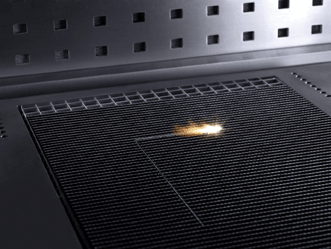
The TruCoax 1000 enables laser cutting of CFRP (carbon fiber reinforced plastic). Photo courtesy of Trumpf GmbH.
This is a mammoth task, made easier with imaging: Multispectral and hyperspectral imaging systems, originally used for military/defense intelligence surveillance and reconnaissance missions, pick up the unique spectral signatures of reflected wavelengths and characterize them. What the eye cannot distinguish, hyperspectral sensors can.
“Environmental laws and regulations, particularly in Europe, have driven demand for more effective remote sensing and sampling techniques,” said David Bannon, CEO of Headwall Photonics Inc. in Fitchburg, Mass. “The ability to successfully distinguish the spectral fingerprints reflected from any sort of matter allows hyperspectral imaging to find a home in ‘green’ applications ranging from the manufacture of solar panels to plastic recycling to efficient mining practices.”
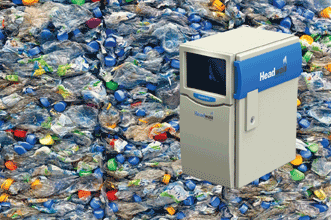
Hyper- and multispectral imaging technology provides a very high degree of accuracy when classifying – and then sorting and separating – materials along high-speed recycling lines. Photo courtesy of Headwall Photonics Inc.
Tailoring its sensors for use on high-speed recycling lines prompted Headwall to develop the only hyperspectral and multispectral sensors that use aberration-corrected optics – i.e., diffraction gratings. Such sensors are more precise over a very wide field of view, ideal for high-speed lines that can be 2 m wide or more.
“Aberrations known as ‘smile’ and ‘keystone’ are eliminated, thanks to the use of these diffraction gratings, which represent the optical engine of the sensor,” Bannon said. “The wider the conveyor line, the more recycled material can be processed in any given unit of time with the advantage of cost-effective processing.”
And the economics work, Bannon insists: Hyperspectral sensors not only keep pace with line speed, but they also can communicate with downstream robotics to successfully separate the material.
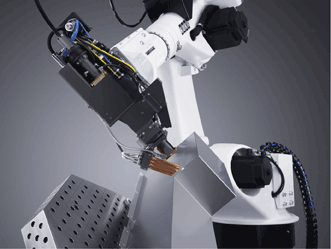
The TruLaser Robot 5020 enables laser welding of an aluminum cable cover. Photo courtesy of Trumpf GmbH.
“The faster the line can operate, and across a very wide field of view, [the more] recyclers can successfully invest in hyperspectral sensors because the payback is a quantifiable one,” he said.
And it’s not only recycling plants that can benefit from these “smart” sensors: They can extend the capabilities and analytical processing of traditional machine vision cameras, which means less waste, higher throughput and greater profit for the user.
Environmental concerns have driven the demand for smaller sensors that can be carried onboard UAVs (unmanned aerial vehicles). In the summer of 2014, Headwall introduced its high-resolution chlorophyll fluorescence sensor for airborne deployment to the Japan Aerospace Exploration Agency.
“Being able to ‘see’ chlorophyll fluorescence means targeting visible to [the] near-infrared spectral range of 750 to
775 nm,” Bannon said. “By analyzing chlorophyll fluorescence, overall plant health and vitality can be determined. This results in better planting and harvesting decisions by crop scientists, which in turn can impact global economies.”

Using Luxeon CoB with CrispWhite Technology LEDs, retail shops can highlight the richest whites, vibrant reds and colors that pop. Photo courtesy of Philips Lumileds.
In addition, hyperspectral imaging can detect and identify a range of deleterious environmental conditions that otherwise cannot be seen – the presence of disease conditions, for example, seen only on treetops. And the ability to analyze trends means that important decisions can be made regarding resource utilization or prioritizing disaster response.
Lasers
Industrial lasers have revolutionized production for manufacturers, and increasing pressure for greener processes in ablating, brazing, hardening, welding, cleaning and cutting spells big business for laser makers.
Today’s car manufacturers, for example, are striving for reduced energy consumption in their manufacturing, which means that production plants are no longer evaluated only in terms of costs and quality, but also in terms of energy efficiency.
“There is a worldwide trend toward energy-efficient products and energy-efficient production that is driven by laws and regulations, as well as marketing aspects,” said Klaus Löffler, head of international sales and a member of the managing board at Trumpf Laser- und Systemtechnik GmbH in Ditzingen, Germany. “Laser technology is a true enabling technology that can lead to energy-efficient products, because it enables completely new manufacturing processes that do not only change the way a product is produced but also expands the design possibilities.”
The biggest impact on Trumpf’s research is the development of high-power, high-brightness diode lasers, Löffler said. While diode lasers are inherently more efficient, high-power diode lasers lack the beam quality needed for many applications.
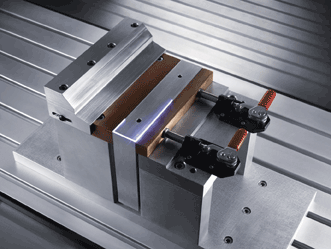
Laser welding enables improved battery housings for single cells in battery blocks for electric cars. Photo courtesy of Trumpf GmbH.
“Research and development of direct diode lasers is a high priority at Trumpf due to their high efficiency. The newest generation of diode lasers is already suitable for laser welding,” he said. “A big challenge is still to improve the beam quality of diode lasers to be suitable not only for brazing, hardening and welding, but also for remote welding and cutting. As of now, we cannot foresee when the technology will be at that point.”
Other green developments to the company’s lasers include:
• An intelligent energy-saver mode, comparable to that found in modern computers. While in this standby mode, the laser consumes less energy, but full power and functionality are still available within seconds.
• Released in April 2014, the energy-efficient TruFlow CO2 laser enables energy savings of 30 percent compared with similar lasers. An innovative water-cooling system enables much more efficient cooling.
• In the future, Trumpf’s lasers will be intelligently connected and controlled to distribute laser power among different machines, maximizing the average usage of a laser.
Lighting
LEDs offer huge potential for energy savings, and with 20 percent of electricity consumption in the U.S. being used for lighting, the push to conserve power has driven LED technology close to its technical limit.
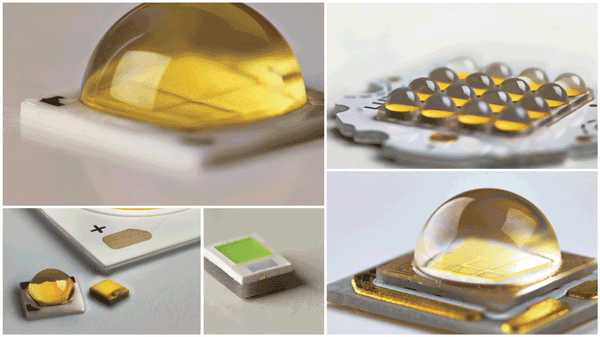
Philips Lumileds offers a comprehensive portfolio of application-optimized LEDs. Photo courtesy of Philips Lumileds.
Pioneers in solid-state lighting for over 15 years, Philips Lumileds, with headquarters in San Jose, Calif., continues to improve its optoelectronics and materials-physics know-how in response to today’s lighting revolution. Having been banned and no longer for sale in many developed countries, the incandescent lightbulb has left a sizable gap in the market.
Since Philips’ first illumination-grade LED components became available in 2001, LED efficacy has increased tenfold, thanks to the following technological improvements:
• Epitaxial growth of III-V nitride single-crystal materials improved to achieve highest internal quantum efficiency for the generation of photons.
• The extraction efficiency of LED chips increased.
• Suitable phosphors were developed for high-efficiency light generation. Phosphors convert blue photons generated by the InGaN active region into a broad spectrum perceived as white by the human eye.
• Robust LED packages enable reliable illumination performance.
• Continued innovation in high-volume manufacturing helps lower LED price.
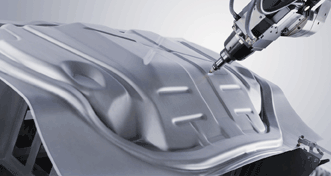
Flexible laser systems from the TruLaser Cell Series 7000 enable processing of two- or three-dimensional components or tubes. This applies to manufacturing prototypes, as well as high-volume serial production. Photo courtesy of Trumpf GmbH.
Future innovation will focus on cost reduction and the tailoring of LED design to meet the needs of a specific application, according to Werner Goetz, senior director of illumination product strategy and systems at Philips Lumileds.
“This will open the floodgates for LED adoption and enable substantial reduction of the electricity consumption used for lighting,” Goetz said.
“White LEDs based on III-V nitride semiconductors and phosphor conversion will continue to advance in efficacy, albeit in smaller steps, since many of the efficiency elements in an LED are approaching their theoretical maxima.”
Global Environmental Initiatives:
• RoHS (Europe and China) – Restriction of Hazardous Substances Directive.
• REACH (EU) – Registration, Evaluation, Authorization and Restriction of Chemicals.
• WEEE (Europe) – Waste Electrical and Electronic Equipment.
• JAMP (Global) – Joint Article Management Promotion, a global chemical information exchange initiative.
• PFOS (EU) – Initiative to ban perfluorooctane sulfonate.
• PoHS (Norway) – Prohibition on certain hazardous substances in consumer products.
Global Energy Targets and Incentives
• In 2007, the European Union agreed to decrease energy consumption by 20 percent by 2020.
• China has committed to reduce the CO2 emission per generated RMB (renminbi) by 40 percent by 2020.
• In Germany, among other countries, companies can receive tax abatements when investing in new machines that have significantly lower energy consumption.
• EU car manufacturers must decrease their fleet’s CO2 emission by 25 percent, and from 2020, cars must have a CO2 emission lower than 95 g/km on average.
• China banned scooters with two-stroke engines from their cities, leading to an unprecedented boom for electronic scooters. Daimler’s new electronic car “Denza” is subsidized by the Chinese government with RMB 120,000 ($19,500).
• In the U.S., average fuel consumption must be reduced to 1 U.S. gallon per 100 km for cars and to 1.4 U.S. gallons for small trucks by 2025.